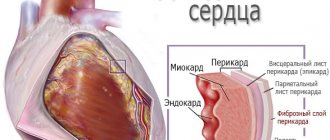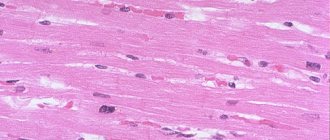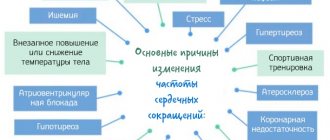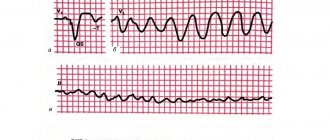Inflammation of the muscular lining of the heart can occur not only in adults, but also in children. Most often this occurs in children aged 4-5 years, as well as in teenagers. Moreover, in children, the cause of infectious myocarditis can be any infectious disease, even seemingly harmless ARVI, but myocarditis develops quite quickly.
Features and characteristics of the disease
The term “myocarditis” means a disease that is accompanied by an inflammatory process in the heart muscle. This disease is diagnosed in patients of different ages. Myocarditis in a child or adolescent can hardly be regarded as a rare case.
The causes of inflammatory damage to the myocardium can be very different, ranging from the penetration of infection into tissues and ending with severe allergic reactions and intoxications. Quite often, inflammation affects not only the heart muscle, but also neighboring structures, including the pericardium, blood vessels and other organs.
Prognosis and complications
The consequences of childhood myocarditis can be myocardial sclerosis, when connective tissues grow and form a rough scar, which causes disruption of the functionality of the organ. In addition, inflammation can involve the outer and inner muscle layer and lead to pericarditis and endocarditis. The result is always the same - heart failure and circulatory pathology of the whole body. In half of the situations, this is caused by an advanced disease, its chronic form.
The poor prognosis mainly concerns newborns, and the percentage of deaths is still high among them. Sclerotic changes that remain in infants can provoke various heart diseases in the future.
Children of preschool and school age tolerate the disease more easily and, as a rule, fully recover with timely treatment.
It has been noted that bacterial myocarditis has a milder course, but the viral type has every reason to be considered more dangerous and lead to complications and even the death of the baby.
Main causes of myocarditis
It is believed that inflammation of the heart muscle can be associated with almost any known form of infection:
- In most cases, the “culprits” of myocarditis are viruses - adenoviruses, Coxsackie enteroviruses, as well as parvoviruses, cytomegalovirus, hepatitis and influenza viruses.
- Inflammation of the myocardium sometimes has a bacterial origin. The disease develops against the background of tuberculosis, brucellosis, and bacterial meningitis. The inflammatory process appears when streptococcal infection is activated.
- Damage to the body by rickettsia often leads to inflammation of the heart muscle. Risk factors include Q fever, typhus, and Rocky Mountain fever.
- Pathogenic fungi, in particular fungi of the genus Candida, can act as a pathogen.
- There are also protozoal myocarditis that develop against the background of toxoplasmosis, malaria, and leishmaniasis.
- Helminths (echinococci, trichinella) also provoke an inflammatory process.
- There is also toxic myocarditis, caused by the ingestion of arsenic, mercury, and carbon monoxide.
- Sometimes the disease develops while taking medications, after vaccination or administration of serums.
- Risk factors include snake and insect bites.
- Physical impact, for example, severe hypothermia, overheating, exposure to ionizing radiation on the body also provokes the inflammatory process.
- Other risk factors include systemic lupus erythematosus, rheumatoid arthritis and some other autoimmune diseases.
As you can see, there are a huge number of reasons why myocarditis develops. Diagnosis should include a search for the primary disease, since the success of therapy depends on this.
Reasons for the development of pathology
Numerous unfavorable factors lead to the occurrence and development of myocarditis in a child, including:
- Infections (bacteria, viruses, other pathogenic microorganisms).
- Worm diseases.
- Intoxication of the body (for example, snake bites, wasp bites, exposure to highly toxic chemical elements such as mercury, arsenic).
- Alcohol and drug use (leads to the development of myocarditis in adolescents).
- Aggressive environmental (for example, harmful radiation, low or high temperatures).
- Long-term use of strong drugs (for example, antibiotics, sulfonamide-based drugs, vaccines and serums).
In addition to the above reasons, various types of diseases can lead to illness in a child, such as polio, tonsillitis, diphtheria, fungal, viral or bacterial pathologies.
Forms and varieties of the disease
There are several classification schemes for this disease. The options for the development of the disease depending on the cause have already been discussed above. But during diagnosis, experts pay attention to other factors:
- When it comes to the course of the disease, myocarditis can be acute, chronic or subacute.
- Depending on the severity, the disease can be mild, moderate or severe.
- The doctor also pays attention to the clinical manifestations - in children you can notice a typical form of inflammation, as well as erased and asymptomatic ones.
- The degree of spread of the inflammatory process is also important - in this case, focal (there is an isolated, single area of inflammation) and diffuse myocarditis (the pathology spreads to the entire muscle).
How does myocarditis develop in children? Main stages
Myocarditis in a child develops in several stages - in modern medicine there are three:
- Viremia stage - viral particles (or other pathogens) enter the myocardium. First, they are fixed on the surface of muscle cells, and then penetrate into the myocytes. At this stage, activation of the immune system is observed, which is accompanied by increased synthesis and release of interferon.
- An autoimmune stage, in which the immune cellular response is significantly enhanced and the level of anticardiac antibodies increases, which accumulate in the myocardium, negatively affecting its function. At the same stage, inflammatory mediators are activated. Microvascular damage is observed.
- If the course of the disease is favorable, then there is a decrease in edema and the formation of fibrous areas on the heart muscle. If therapy does not produce positive results (or is completely absent), the disease becomes chronic. With chronic inflammation, complications gradually develop, including heart failure, cardiomegaly, and cardiosclerosis.
The diagnostic process and examination of the child help the doctor find out the form of the disease, its causes, as well as the stage of development - only after receiving this data can a truly effective treatment regimen be drawn up.
Therapeutic measures
Treatment of myocarditis in children is aimed at combating heart failure.
- If an immunological mechanism is present, then anti-inflammatory treatment of myocarditis is carried out with non-steroidal anti-inflammatory drugs (diclofenac, aspirin, etc.).
- In case of vascular damage, myocarditis therapy includes drugs to improve microcirculation (heparin, trental, chimes).
- For bacterial etiology of myocarditis, therapy is carried out with antibiotics based on the sensitivity of the pathogen.
- During the recovery period of myocarditis, treatment is carried out with cardiotrophic drugs (neoton, carnitine, etc.) and vitamins.
- In the presence of heart failure, myocarditis is treated with cardiac glycosides.
Treatment of endocarditis is based on the influence of the pathogen through the use of antibiotics and sanitation of foci of infection.
If inflammation progresses and treatment measures are ineffective, surgical treatment is indicated.
Symptoms of the disease in a newborn
Signs of the disease depend on many factors - here it is worth taking into account the age of the child, the origin and form of the disease. Myocarditis is most severe in newborns. The baby slowly gains weight, becomes drowsy and inactive, as even the process of feeding tires him greatly. The child's skin is pale and often takes on a gray tint.
Another symptom is shortness of breath. It first appears during periods of activity - the baby breathes quickly and heavily while changing clothes, bathing, defecating, and feeding. As the disease progresses, breathing difficulties can be observed even in a calm state. Due to developing heart failure, edema appears - sometimes it is very pronounced, due to which the baby’s weight increases sharply. Examination of the child reveals an enlarged liver and spleen.
Endocarditis
The concept of infective endocarditis refers to inflammation of the inner lining of the heart. It occurs due to damage to the membrane by streptococcus or staphylococcus. Predisposing factors for the development of infective endocarditis are decreased immunity, the presence of foci of infection in the body, and endocardial trauma.
The clinical picture of infective endocarditis consists of symptoms of damage to the inner membrane, intoxication and thromboembolic complications and undergoes several phases of development.
- The infectious-toxic (initial) phase of infective endocarditis is manifested by symptoms of intoxication: fever, chills, sweating. After some time, signs of valvular damage appear (changes in heart sounds over the affected valves). Thromboembolic complications begin to appear.
- The immunoinflammatory phase of infective endocarditis occurs with the deposition of immune complexes. Externally, this is manifested by painful Osler nodes on the fingertips, erythematous painful Janeway spots on the palms and soles, small areas of hemorrhages with a white spot in the center (Liberman-Lunin spots), retinal hemorrhages (Roth spots), subungual hemorrhages.
During this phase of infective endocarditis, anemia develops, an enlargement of the spleen occurs, and abacterial damage to the liver, kidneys and pancreas occurs.
In the dystrophic phase of infective endocarditis, cardiac, renal and liver failure develops. This phase is irreversible and incurable.
Features of the clinical picture in a child over two years old
In older children, the clinical picture looks different. Within 2-3 weeks after the initial infection, myocarditis does not appear at all. Then the symptoms become more pronounced. Signs of the disease include:
- pale skin;
- fatigue, weakness, slight increase in temperature;
- loss of appetite and, accordingly, loss of body weight;
- soreness in muscles and joints, and sometimes in the abdomen;
- as the disease develops, children begin to complain of pain in the heart area;
- shortness of breath and rapid heartbeat appear.
Myocarditis: diagnosis of the disease
With such a disease, correct diagnosis is of great importance. It is best to contact the children's cardiology center with your child. To make a diagnosis, the following procedures are necessary:
- To begin with, a survey of the child and parents is conducted to take an anamnesis and determine the presence of certain symptoms.
- Already during the examination, the doctor may suspect myocarditis - the specialist observes pallor, even cyanosis of the skin, rapid heartbeat, the presence of edema and shortness of breath.
- A biochemical and serological blood test is performed, which makes it possible to determine the presence of infection and inflammatory process.
- X-ray of the chest organs allows the specialist to see the expansion of the boundaries of the heart and the presence of stagnation of blood in the vessels of the lungs, which confirms the presence of an inflammatory process in the myocardium.
- Electrocardiography and echocardiography are required - such procedures make it possible to examine the functioning of the heart and assess the degree of disturbances.
- Myocardial biopsy is indicated only in the most severe cases, as it helps determine the extent of the inflammatory process.
Prevention
- Timely examination of a woman before pregnancy and compliance with precautions during pregnancy are of great importance.
- Prevent your baby from coming into contact with sick people.
- Get vaccinated on time and follow the vaccination schedule. During a flu epidemic, also get the appropriate vaccination.
- If chronic diseases occur, in particular, sinusitis or tonsillitis, stop them in a timely manner.
- If you have any complaints about your health, consult a doctor in a timely manner and follow all his recommendations.
- If there is an infectious process in the baby’s body, limit his physical activity.
- Establish a daily routine and strictly follow it.
Now you know what myocarditis is, what clinical recommendations for recovery exist. As you can see, sometimes difficulties arise in making a diagnosis; it is especially difficult to identify this disease in young children who are not yet able to speak and complain of feeling unwell. Be aware of the possible complications of myocarditis. At the first suspicion of heart problems, consult a doctor, do not delay.
Treatment of the disease: what do doctors offer?
Of course, therapy depends on the cause and degree of development of the disease. For example, in the presence of a bacterial infection, antibiotics are needed, and in case of viral infections, antiviral drugs are indicated. Children are also prescribed immunomodulators to normalize the functioning of defense mechanisms.
To eliminate the inflammatory process, patients take anti-inflammatory non-steroidal drugs (Voltaren, Brufen, Indomethacin). In especially severe cases, steroid hormonal medications are used, which are more effective in combating inflammation. To eliminate edema, diuretics are used to get rid of excess fluid. It is also important to include vitamin preparations in the treatment regimen. If we are talking about a chronic process, then sanatorium treatment is indicated. If persistent arrhythmia occurs that does not respond to drug treatment, a pacemaker may need to be implanted.
Treatment is carried out in a hospital setting, it is advisable to choose a good children's cardiology center with good specialists. At the end of the course of therapy, the child must still undergo regular examinations - first every few months, and then twice a year (if the course of the disease is favorable). Echo and electrocardiography, chest x-ray, blood tests should be done periodically - this is the only way to notice a relapse or the presence of complications in time.
Treatment methods
For complex treatment of myocarditis and eliminating the cause of its occurrence, antiviral drugs (when the disease was caused by a viral infection) and antibiotics (for bacterial infection).
To suppress the source of inflammation, non-steroidal drugs and hormonal glucocorticoid drugs are prescribed, which have a pronounced anti-inflammatory effect and also help relieve pain in the heart area.
The administration of gammaglobulin allows the activity of the heart muscle to be restored If there is a risk of developing heart failure, medications such as Dopamine and Dobutamine are prescribed.
If a child experiences swelling of soft tissues, it is necessary to take diuretics that normalize the processes of removing excess fluid from the body. And in case of heart rate disturbances, antiarrhythmic drugs .
In case of severe myocarditis, in especially severe cases, when conservative therapy does not give the expected effect, surgical intervention is necessary.
There are such types of surgical operations as:
- transvenous cardiac pacing;
- implantation of a cardiac pacemaker.
Diet of a child with myocarditis
Many parents today are interested in questions about why myocarditis develops and what it is in a child. Symptoms and treatment of the disease, its causes are, of course, important points. But it is worth considering that during therapy the child needs a special diet (if we are not talking about a baby).
Experts recommend giving up simple carbohydrates—do not give your child baked goods, chocolate, white bread, or pasta. You can replace them with baked goods without yeast. Also, do not overuse salty and spicy foods, fatty meats and fish, rich soups and broths - it is better to eat lean chicken fillet and liver (by the way, it is advisable to steam dishes). Fish is allowed, but only if we are talking about low-fat varieties. The number of eggs should also be limited.
The diet should include fermented milk products, fresh fruits and vegetables (except plums, quinces, hard pears and apples, grapes). Chocolate and other sweets can be replaced with honey, jam, marshmallows and marmalade.
Prognosis for myocarditis
Myocarditis in a child is especially dangerous in the first months of life - it is in this age group of patients that death is most often observed. Prognosis depends on the form and severity of the disease. For example, a mild form of the disease sometimes does not require treatment at all. Bacterial inflammation is easier to treat, but with a viral infection, the outcome of the disease may not be very good.
Adverse cases are rarely recorded among school-age children and adolescents - as a rule, children recover fairly quickly and return to normal life. True, sometimes during myocarditis sclerotic areas form in the heart, which can cause the development of heart failure in adulthood.
Infections are the enemy of a child's heart
Infectious myocarditis
Myocarditis in children of infectious origin is a disease that affects the heart muscle and occurs as a complication after an infection. But can any infection cause this cardiac pathology in children? The most common causes of infectious myocarditis are:
- Viruses - coxsackie enterovirus, influenza, adenovirus, herpes simplex, and ECHO.
- Bacteria that can cause diseases such as meningitis, diphtheria, leptospirosis, salmonellosis. In children under one year of age, myocarditis of a bacterial nature can be provoked by umbilical, skin sepsis, or bacterial dental infection.
- Parasitic infestations - toxocariasis, echinococcosis, amoebiasis. These infections in children can cause heart complications - infectious myocarditis.
- Fungal infections - candidiasis, actinomycosis can also not pass without leaving a trace, but with complications on the myocardium.
Preventive agents
Unfortunately, there is no universal cure for myocarditis. Nevertheless, experts recommend following some rules. A pregnant woman should be attentive to her health, prevent the development of infectious diseases, avoid contact with toxins, and get tested regularly.
The condition of the newborn should be carefully monitored - infectious and inflammatory diseases should be diagnosed and treated in a timely manner. During outbreaks of colds, if possible, you should not allow your child to come into contact with infected people. Proper nutrition, a clear daily routine, moderate physical activity and hardening will have a positive effect on the state of the immune system.











